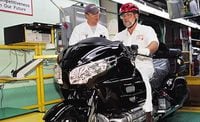In a bit of a stunner, American Honda announced that motorcycle production at its plant in Marysville, Ohio, will cease in 2009. That production, currently of all GL1800 Gold Wing and VTX cruiser models, will move to a “newly expanded and state-of-the-art factory in Kumamoto, Japan.” At the same time, Kumamoto will also take over production now taking place in Honda’s original plant in Hamamatsu.
Honda says the timing has nothing to do with the current economic downturn. Those employed making motorcycles will be offered positions in Marysville’s auto-manufacturing activities. No lay-offs are planned. These changes do not affect Honda’s North American auto production, currently taking place in seven plants.
Manufacturing is not a static process, but continually develops new techniques and processes. Existing facilities could be upgraded, but it usually costs less to start over. I suspect that the Kumamoto plant will cut production costs with such new methods and will also likely provide greater flexibility. This would include the ability to produce more than one product simultaneously on the same line, or to quickly shift production from one product to another as sales trends appear.
Honda motorcycle production in Marysville began in 1979 with the CR250R motocrosser and has since produced 2.25 million motorcycles and ATVs.
This calls to mind a discussion I had with a production engineer about possible savings in producing offshore. He said to me, “If you get on a plane the instant you discover a problem, you’ll have five weeks of production in the pipeline that isn’t fixed by your solution.” That’s a lot of re-work to pay for. What this means is that when planning, engineering and production are all in the same place, mistakes or adjustments are less costly. Doesn’t this apply to automobiles? Imported autos are subject to tariff, but given sufficient production numbers, assembling or producing them in the destination country, even though more expensive, can save money by avoiding this.

/cloudfront-us-east-1.images.arcpublishing.com/octane/5BDFMBN2KJE7JNJK7LJ7EG4A2M.jpg)
/cloudfront-us-east-1.images.arcpublishing.com/octane/C3WGBZCFABC7XKBCFCCXDWYWME.jpg)
/cloudfront-us-east-1.images.arcpublishing.com/octane/PLQ5M7MG3RG7BHYH2OILWJZIPY.jpg)
/cloudfront-us-east-1.images.arcpublishing.com/octane/CCPZFYVVRBF2DLPMDYKPF4TMME.jpg)
/cloudfront-us-east-1.images.arcpublishing.com/octane/SIAXQ2ZOPNBYBLPKJPCHIYGG6A.jpg)
/cloudfront-us-east-1.images.arcpublishing.com/octane/LRRTQXMMAFBVFOUYC2RI6ZBEAY.jpg)
/cloudfront-us-east-1.images.arcpublishing.com/octane/2NE3IENERFBTPDKVXPNTSMZZXE.jpg)
/cloudfront-us-east-1.images.arcpublishing.com/octane/7EG6FR6QOJGR7FFROLIPDUVTVM.jpg)
/cloudfront-us-east-1.images.arcpublishing.com/octane/QC73NNGYHZDWTNVTLNABEDJJ2Y.jpg)
/cloudfront-us-east-1.images.arcpublishing.com/octane/LMMTOYLL7BGE3FLR3OXDA4YQUI.jpg)
/cloudfront-us-east-1.images.arcpublishing.com/octane/EGXXXTWM2NABTOFTZBMZ2MWLUQ.jpg)
/cloudfront-us-east-1.images.arcpublishing.com/octane/EKKSANJIXNHQTNCANRHSTW7JHE.jpg)
/cloudfront-us-east-1.images.arcpublishing.com/octane/QSA4M5BQLFBAHIX33LEC63FH6M.jpg)
/cloudfront-us-east-1.images.arcpublishing.com/octane/OK3LWSOK3ZCMHJZZCEHOL2SRKQ.jpg)
/cloudfront-us-east-1.images.arcpublishing.com/octane/4E4BRX2RXVGNPCK4ODPMSUVBC4.jpg)
/cloudfront-us-east-1.images.arcpublishing.com/octane/SSLY6CGFJNDLVKSP5LBWZKVIHU.jpg)
/cloudfront-us-east-1.images.arcpublishing.com/octane/ENCTP2GIJ5DFVH2QPFJRFJ3IDI.jpg)
/cloudfront-us-east-1.images.arcpublishing.com/octane/P67HV34OANAFBDVK6U4FQ2M3YM.jpg)
/cloudfront-us-east-1.images.arcpublishing.com/octane/TG75U5MBR5FI3INUFFJEFMCOZI.jpg)
/cloudfront-us-east-1.images.arcpublishing.com/octane/T57XZZK3NVEHDPALKA6BHQ6HSI.jpg)
/cloudfront-us-east-1.images.arcpublishing.com/octane/AHKROF6VQFHGTDJUON7HYST3SE.jpg)
/cloudfront-us-east-1.images.arcpublishing.com/octane/WT6GUJIIQ5AFJPUZFOKJQUCM7I.jpg)
/cloudfront-us-east-1.images.arcpublishing.com/octane/2W2YYLKRUJHW5CQOQSZPOVNHI4.jpg)
/cloudfront-us-east-1.images.arcpublishing.com/octane/WOG6MLRJJRGFXHGMEZ5CT6OBKA.jpg)